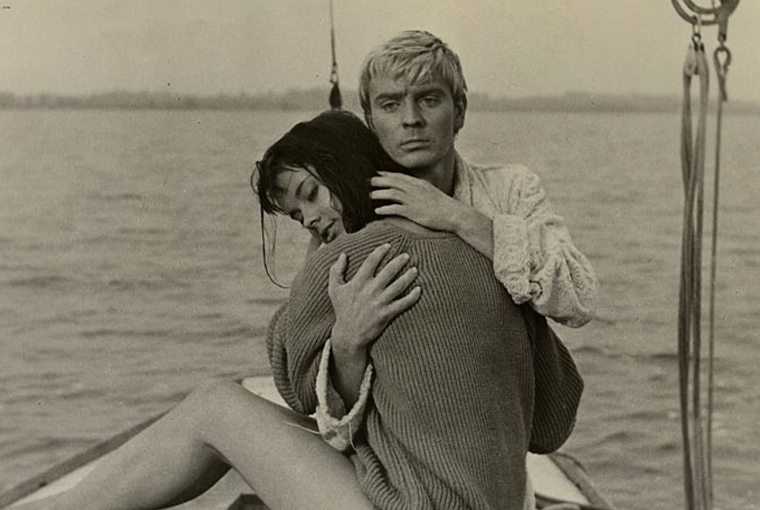False Enigma
Roman Polanski’s Knife in the Water (Nóż w wodzie, 1962)
Vol. 5 (May 2011) by Konstanty Kuzma
Knife in the Water is one of the most important works of Polish cinema that (although being his only film made in Poland) puts Roman Polanski’s name beside those of Andrzej Wajda, Krzysztof Kieslowski and Krzysztof Zanussi.
Trying to reinterpret Knife in the Water seems like a venturous attempt if one considers the number of reviews written on Polanski’s ground-breaking debut film over the course of the 50 years that have passed since. When it first came out, it received international attention despite its origin in socialist Poland – notably- via the Oscars nomination and an immediate interest from American and British media. Unlike Kieslowski’s and Zanussi’s debut films that received little recognition outside Poland, Knife in the Water is widely considered among Polanski’s most important films, and thus asks for a new approach.
In the beginning of the film, a married couple picks up a hitchhiker who stands in the middle of the road, forcing their car to stop. Andrzej- the husband- played by Leon Niemczyk, ignores the implicit provocation in this act, and decides to give the young man a lift, and soon after, invites him to his yacht. From then on, the story revolves around a play of power between the young man and Andrzej- his older foil.
On the yacht, we find not only the title object – the knife – but more importantly, Andrzej’s wife Krystyna (Jolanta Umecka). Andrzej and the young man- the autocrat versus the rebel- relentlessly take on new challenges to impress Krystyna, like two cartoon characters outbidding each other with the size of their weapon. It is a generational conflict, a sexually-charged one, and one of social status that escalates in the morning of the second day. After a heated exchange, the young man can’t find his knife, and finally, the two start fighting. Andrzej wins the fight and pushes the young man off the boat, but soon the winner turns into the culprit. The young man pretends to have drowned, and Krystyna confronts Andrzej with the possibility of murder.
Krystyna’s position in the film is particularly interesting, because it is often marginalized. It is arguable whether Krystyna is only an object of desire, or rather the subject controlling the game. Polanski enhances this ambiguity because Krystyna is the only character that goes through a change, moving from a submissive role in the beginning of the film to a display of disobedience against the patriarchy. However, Andrzej’s character seems closer to the concept of a protagonist, as he makes key decisions that determine the plot development. It is he who decides to take the young man on the trip, who pushes him off the boat, and finally flees his wife.
When Andrzej leaves, the young man returns to Krystyna and the boat. After an ambiguous love scene between the young man and Krystyna, the story is framed with the married couple driving in their car again. The triangular constellation between Andrzej, Krystyna and the young man has been canonized as an Oedipal conflict. And although this interpretation is suggestive and the Freudian references are abundant, this may only mystify the film unnecessarily. Can we call the conflict “subtle”, or the violence and sexuality “undertones”? Not only is the conflict obvious, it is openly acknowledged by the characters. When the young man agrees to enter the sailing boat with the couple at the beginning of the film, he tells Andrzej that he knew he would be ready to “play the game”. In the end, Krystyna summarizes that very game in a sort of expository dialogue with the young man, as if the two men did not admit to it themselves. Neither does Polanski refrain from showing nudity, nor violence. Lastly, even though Polanski himself said that he didn’t have a hidden symbolism for the knife in mind prior to shooting, it is hard not to interpret the title as a direct reference to failed potency. Knife in the Water is rather acute than subtle; nothing is left unsaid, everything the audience fears takes place potentially. The thing that provokes the acute tension and, in my opinion, makes up the essence of Knife in the Water, is the fact that everything is presented as a potentiality rather than being fulfilled – the death of the young man – the parting of the couple, and even the lie of Krystyna and the arrest of Andrzej. Knife in the Water shouldn’t be understood as a subtle conflict, but rather bold in that it gives in to its sexual and violent potential.
Despite this explicitness, the love scene between Krystyna and the young man remains unexplained. The atmosphere of the scene seems almost matter-of-factly, the act of love-making being shown as an inevitable and necessary interaction without passion or elaboration. However, if we understand Andrzej, the husband, as the protagonist of the film, a quasi-narrator, then this scene could be taken as a simple fantasy. Like from the perspective of Dr. William Harford played by Tom Cruise in Kubrick’s Eyes Wide Shut, here, too, we could be presented with an image originating from the jealousy of a naive man, wherein lies the unsolved tension of the ending: we do not know whether the act of lust between the young man and Krystyna has been fulfilled. Potency stays potentiality – a knife in the water…
Knife in the Water is diligently executed, and its iconic cinematography, archetypal characters and exposed symbolism seem almost theatrical. But is it necessary to understand the knife in Polanski’s film as an enigma? In his book on Jean Renoir, André Bazin condemns bad films for playing with indecipherable symbols that fully detach the story from reality. A good film is not made by its potential for being argued about. I believe that in many ways Knife in the Water has been over-analyzed in the name of an intellectual discussion that – even while remaining intellectual – might have missed a point.




Leave a Comment